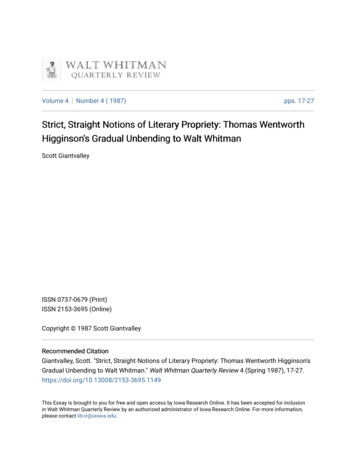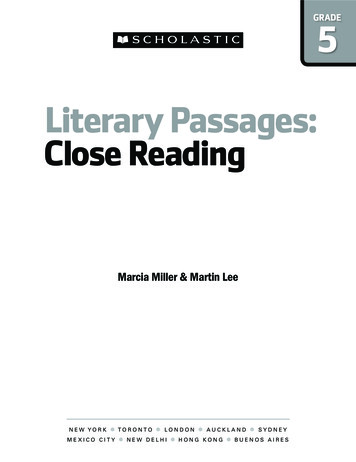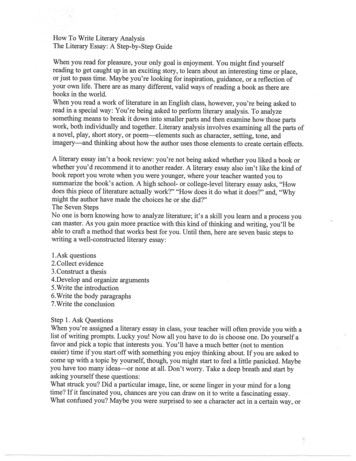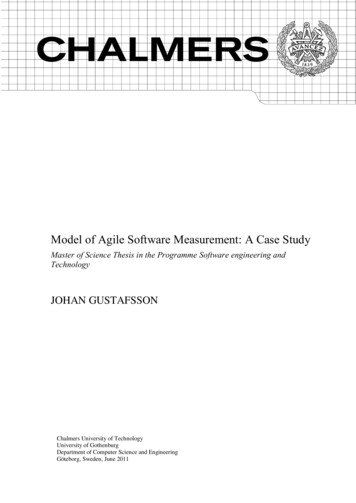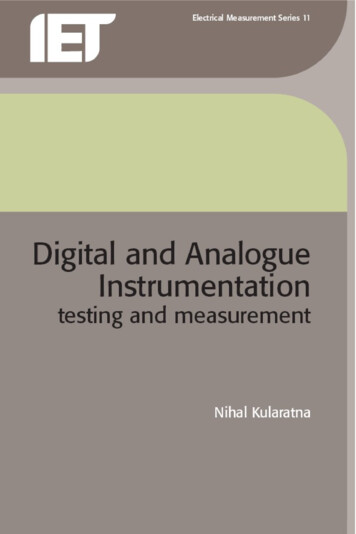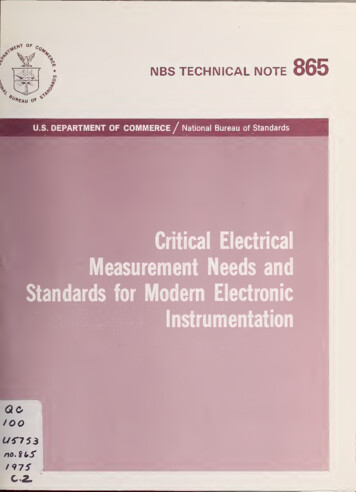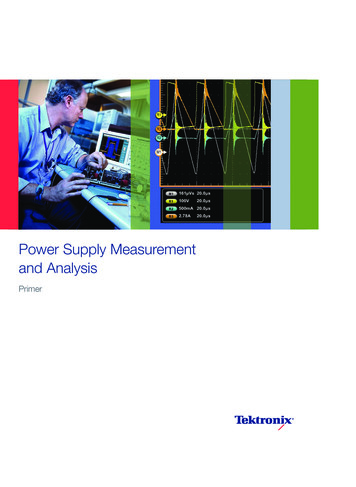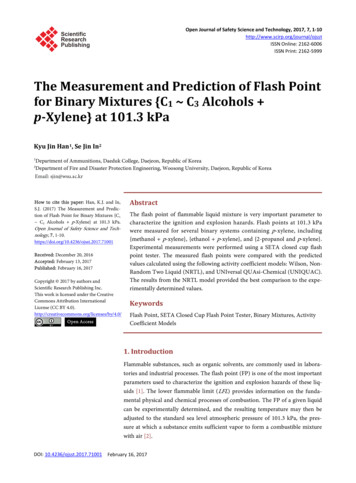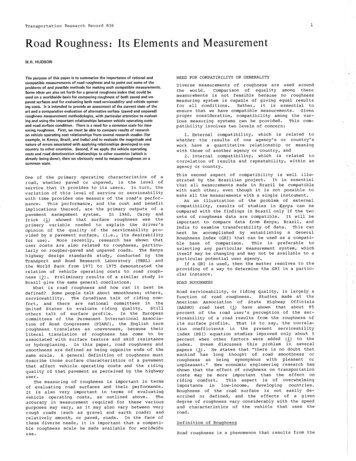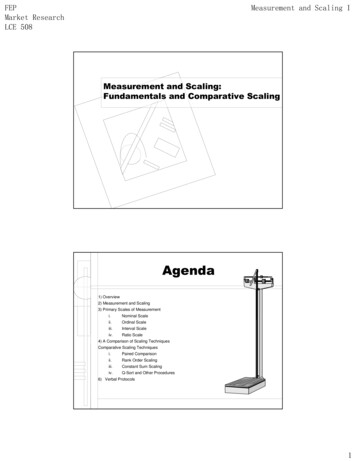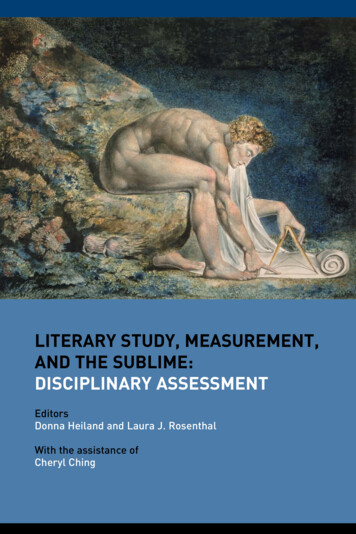
Transcription
LITERARY STUDY, MEASUREMENT,AND THE SUBLIME:DISCIPLINARY ASSESSMENTEditorsDonna Heiland and Laura J. RosenthalWith the assistance ofCheryl Ching
LITERARY STUDY, MEASUREMENT, AND THE SUBLIME:DISCIPLINARY ASSESSMENTDONNA HEILAND AND LAURA J. ROSENTHAL, EDITORSWITH THE ASSISTANCE OF CHERYL CHING
The Teagle Foundation is a New York-based philanthropic organization thatintends to be an influential national voice and a catalyst for change to improveundergraduate student learning in the arts and sciences.The opinions, interpretations, and conclusions expressed in the essays included inthis collection are the authors’ own and should not be attributed to theFoundation.Copyright 2011 by The Teagle Foundation.“18-Item Need for Cognition Scale” by John T. Cacioppo, Richard E. Petty, andChuan Feng Kao was first published in Journal of Personality Assessment 48.3 (1984)and is reprinted with permission of the authors.“A Progressive Case for Educational Standardization: How Not to Respond toCalls for Common Standards,” by Gerald Graff and Cathy Birkenstein was firstpublished in the May-June 2008 issue of Academe. Copyright 2008 by AmericanAssociation of University Professors. The essay has been revised by the authorsand is reprinted with permission of the original publisher.“Elephant Painting” by Hong, date unknown, is reprinted with permission fromExoticWorldGifts.com.Published by The Teagle Foundation570 Lexington Avenue, 38th Floor, New York, New York 10022www.teagle.orgAll rights reserved. No part of this publication may be reprinted, reproduced ortransmitted in any format or by any means electronic or mechanical, includingphotocopying, recording and information storage and retrieval, without writtenpermission from the publisher.Editorial inquiries and permission requests should be sent to The Teagle Foundationby mail (see the address above) or electronic mail (info@teaglefoundation.org).ISBN: 978-0-9831236-0-6Cover image: Newton by William Blake, 1795/circa 1805.Photo credit: Tate, London / Art Resource, NYBook design by Swandivedigital.Set in Baskerville.
For Bob Connor, an extraordinary leader for the humanitiesand for liberal education.
TABLE OF CONTENTSFOREWORD . 7Richard L. MorrillINTRODUCTION . 9Donna Heiland and Laura J. RosenthalAssessment, Liberal Education, and Literary StudyTRANSFORMATIVE LEARNING—MINE AND THEIRS . 27Carol Geary SchneiderMAKING THE CASE FOR DISCIPLINE-BASED ASSESSMENT. 47Rachelle L. BrooksWHERE HAS ASSESSMENT BEEN IN THE MODERN LANGUAGE ASSOCIATION?A DISCIPLINARY PERSPECTIVE . 59Rosemary G. Feal, David Laurence, and Stephen OlsenMEASURING THE HUMANITIES: THE SLIPPERY SLOPE FROMASSESSMENT TO STANDARDIZATION . 69Michael HolquistSublimity, Creativity, and LearningTHE PYGMIES IN THE CAGE: THE FUNCTION OF THE SUBLIME IN LONGINUS . 97W. Robert ConnorAPPROACHING THE INEFFABLE: FLOW, SUBLIMITY, AND STUDENT LEARNING . 115Donna HeilandFEARFUL SYMMETRIES: RUBRICS AND ASSESSMENT. 133Sarah Webster GoodwinPOSTHUMANIST MEASURES: ELEPHANTS, ASSESSMENT,AND THE RETURN OF CREATIVITY. 153Lucinda ColeASSESSMENT IN LITERARY EDUCATION . 171Charles Altieri
Politics, Institutions, and Disciplinary GoalsASSESSMENT, LITERARY STUDY, AND DISCIPLINARY FUTURES. 183Laura J. RosenthalTHE FUTURE OF LITERARY CRITICISM: ASSESSMENT, THE CURRICULARIZEDCLASSROOM, AND THICK READING . 199Charles M. TungA PROGRESSIVE CASE FOR EDUCATIONAL STANDARDIZATION:HOW NOT TO RESPOND TO CALLS FOR COMMON STANDARDS . 217Gerald Graff and Cathy BirkensteinENGLISH DEPARTMENTS, ASSESSMENT, AND ORGANIZATIONAL LEARNING . 227David MazellaCase Studies and TemplatesFROM SKEPTICISM TO MEASURED ENTHUSIASM: THE STORY OF TWOLITERARY SCHOLARS’ INTRODUCTION TO ASSESSMENT IN THE MAJOR . 259Kirsten T. Saxton and Ajuan Maria ManceA CAUTIONARY TALE ABOUT SYSTEM-WIDE ASSESSMENT IN THE STATE UNIVERSITYOF NEW YORK: WHY AND HOW FACULTY VOICES CAN AND MUST UNITE . 277Pat Belanoff and Tina GoodREADING FOREIGN LITERATURE CRITICALLY: DEFINITIONS AND ASSESSMENT . 309Jenny Bergeron and Russell A. BermanTHE COLLABORATIVE WORLD LANGUAGES DEPARTMENT:A TEAMWORK APPROACH TO ASSESSING STUDENT LEARNING OUTCOMES . 321José G. Ricardo-OsorioHOW TO CONSTRUCT A SIMPLE, SENSIBLE, USEFUL DEPARTMENTALASSESSMENT PROCESS . 335Barbara E. WalvoordINDEX . 353
FOREWORDTHE TEAGLE FOUNDATION HAS AN active program of communication, reflecting its mission to share the knowledge that arises from its workand the experiences of its grantees. The Foundation’s website is an importantpart of the effort to disseminate ideas and practices and includes a wide variety of reports, opinion pieces, and essays by Teagle staff members, grantees,and leaders in higher education. For the first time, a full-length book is appearing as an original publication on the Teagle website. This collection of essays,Literary Study, Measurement, and the Sublime: Disciplinary Assessment, edited byDonna Heiland and Laura J. Rosenthal, represents an important new venturein the Foundation’s communication program (it will appear in print as well,so that readers can engage with it in the format they prefer). The book isthe product of many authors, including the editors, both of whom havewritten essays for it. But it is the creativity and the persistence of the editors that explains the appearance of this new publication. The editors havereviewed the essays rigorously, to ensure that they meet the highest academic standards.The essays represent an enticing and interesting series of ideas and experiences about the work of assessment in literature and related fields that oftenresist the language and the methods of standard forms of assessment—often,one might add, for very good reasons. Yet it is just the play of ideas and interpretations that one finds in literary studies that highlights the collection. Theopinions of various authors about the uses and the abuses of assessment covera wide spectrum of views that reflect the perspectives that the Foundation findsin its own work with its grantees. This is to be expected and even welcomed,for little learning occurs if answers are easy or consensus is artificial. In publishing this work, Donna Heiland and Laura Rosenthal have contributed significantly to an understanding of the range and the possibilities of assessment,and to the work of the Foundation.Richard L. MorrillPresident, The Teagle Foundation7
8
INTRODUCTIONDONNA HEILAND AND LAURA J. ROSENTHALASSESSMENT IS CURRENTLY RESHAPING the academic landscape. Ina recent survey of over fifty English department chairs and graduate directorsconducted in anticipation of the 2010 meeting of the Association of DepartmentChairs (ADE) East, 86% reported that their department was engaged in someform of learning outcomes assessment (“ADE Survey”). While this high percentage may not necessarily obtain throughout all English and foreign language departments, only two percent of those who responded reported thatthey were neither engaged in assessment projects nor had plans to set one inmotion. Of course, this simple statistic represents a wide range of practices.Inevitably, some departments are spending most of their energy trying to figure out ways to generate just enough information to satisfy the demands ofaccountability; at the other end of the spectrum, some departments are seeingways to use assessment to rethink student learning in their programs. Most fallsomewhere in between. Faculty responses at most institutions inevitably varyas well: some instructors have embraced assessment, some are cautiouslyexploring its possibilities, and others have vehemently protested its institutionalization. Yet, it has begun to reach a saturation point in academic culture.Even Facebook now offers as one of its “Shite Gifts for Academics” an“Overly-Enthusiastic Assessment Guru,” presumably of the kind that no onewants to see at the next department meeting. Love or hate it, learning outcomes assessment is becoming an important part of academic life in Englishand foreign language departments.While assessment has become an occupational reality (and, some mightsay, an occupational hazard), in many professional venues for literary and cultural studies there has been relatively little discussion about this process and itsimplications. While professional issues are regularly and vigorously debated atconferences and in journals, discussions of assessment tend to be relegated tomore administrative venues and treated as practical matters.1 These discussions take place in meetings of campus committees, in departments, and ininformal settings (by this point most instructors have probably opined aboutassessment around the proverbial water cooler), but often do not move muchbeyond these contexts. While most departments, then, are conducting assessment projects, and while many faculty members currently participate in those9
LITERARY STUDY, MEASUREMENT, AND THE SUBLIME: DISCIPLINARY ASSESSMENTprojects, and while many instructors have strong opinions about assessment,few of the questions raised by assessment have attracted the kind of sustainedthought that we give to other aspects of professional life. This collection ofessays attempts to end this silence, asking first of all: if assessment has becomeso pervasive in professional academic life, then how do we account for the limits of the discussion that has so far taken place in our own disciplinary context?This cannot be simply because outcomes assessment is not a literary topic,like Shakespeare or the Harlem Renaissance, as many topics of broader professional interest have attracted attention in recent years. We see publicationsand conference panels on academic freedom, the exploitation of adjunctinstructors, the tenure system, the politics of the classroom, university budgets,graduate student mentoring, and faculty self-governance. As conditions inhigher education change, it often feels like these discussions have become whattheory was in the 1980s: the problems in which everyone has a stake and thatin certain ways generate the most interesting fundamental discussions. Nordoes any lack of interest in teaching or classroom issues among literary scholars explain the under-theorizing of assessment. Our primary professionalorganization, the Modern Language Association (MLA), publishes a series ofbooks devoted to teaching strategies (“Approaches to Teaching”), and prominent scholars have published monographs on the teaching of literature (Graff,Showalter, Tompkins). Most professional organizations devoted to the academic sub-fields in literary study dedicate conference panels to teaching practicesand some offer prizes for course designs. Every job applicant generates ateaching philosophy and must sometimes even show pedagogy in action byteaching a sample class on the campus visit. Further, few topics in literarystudies have attracted greater attention in the general public than what kindsof texts get taught. Newspapers and novelists have dissected conflicts over theliterary canon; careers have been made and lost in their wake.No one can reasonably argue, then, that we overlook teaching as an objectof scholarly and critical attention. Those who teach literature have a significant investment in classroom practice and outcomes; the general public joinsus in significant concern over the choice of works to explore. In spite of thisintense interest in what we teach and even how we teach it, however, untilvery recently, there has been less interest in the overall effectiveness of ourefforts. We are more likely to discuss how we choose our texts than how weknow whether or not we have achieved any of our teaching goals, be they conservative, radical, or in between. Outcomes assessment would seem to be anobvious partner and resource for our work, and yet it often appears to manyfaculty members as fundamentally disconnected from the daily challenges ofteaching and learning. Indeed, for many instructors in higher education, themost interesting question raised by outcomes assessment has been how toavoid getting stuck with it. Why?We propose a three-part answer: 1) assessment has been identified withgovernment mandated accountability measures about which faculty andadministrators have a range of reservations; 2) even when assessment is understood in more progressive terms as a means of improving student learning, it10
INTRODUCTIONhas not been seen as a viable way of furthering the elusive and even ineffableheart of what goes on in literature classrooms; and 3) the best-known assessment efforts have targeted overall institutional performance and general education outcomes rather than the concerns and outcomes of specific disciplines.In what follows, we take up these iss
the pygmies in the cage: the function of the sublime in longinus . 97 w. robert connor approaching the ineffable: flow, sublimity, and student learning . 115 donna heiland fearful symmetries: rubrics and assessment. 133 sarah webster goodwin

